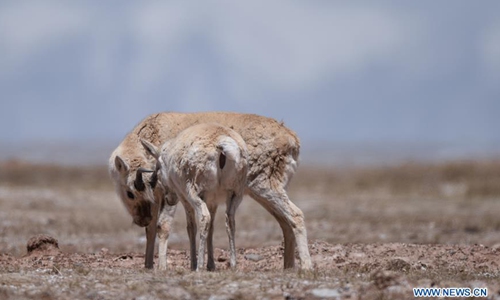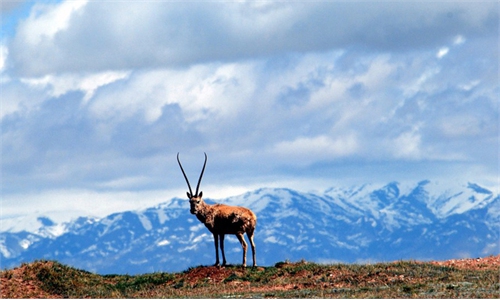
Two Tibetan antelopes are seen in Hoh Xil, northwest China's Qinghai Province, May 15, 2020. Pregnant Tibetan antelopes have begun their annual migration to the heart of northwest China's Hoh Xil nature reserve to give birth, according to the statement released on Friday by the reserve's management bureau. On April 30, the first group of 43 Tibetan antelopes passed the Qinghai-Tibet highway en route to Zonag Lake and other breeding areas in Hoh Xil, about a week earlier than last year. Every year, tens of thousands of pregnant Tibetan antelopes start to migrate to Hoh Xil in May to give birth, after mating in November or December, and leave with their offspring in around August. In July 2017, Hoh Xil became a world heritage site and is home to about 60,000 Tibetan antelopes. (Xinhua/Wu Gang)
Chinese forestry authorities have recently clarified that shawls sold by online vendors claiming they were made of shahtoosh from endangered Tibetan antelopes were actually high-quality cashmere products from Nepal and India, and were falsely advertised as shahtoosh to attract customers.
Wan Ziming, deputy director of the wildlife conservation department from the national forestry administration, said Saturday that an investigation showed that the so-called shahtoosh products sold online were actually high-quality cashmere products from Nepal and India.
In order to attract customers, sellers claimed that their products were shahtoosh shawls made from the wool of Tibetan antelopes, and priced them at 100,000 yuan and above apiece.
The wildlife conservation department has decided to notify market supervision authorities about the investigation results, and a further investigation into the relevant online stores' false advertising will be required.
Global Times noticed on Sunday that keywords such as "shahtoosh," or "toosh" could no longer be found on several e-commerce platforms and social media platforms, however, for the vendors who acknowledge that the advertisements were false, they might face fines of up to five times the advertising cost.
The move by the national forestry administration came after products tagged as "shahtoosh" shawls were found to be sold through Chinese e-commerce and social media platforms, where the sellers referred to them as "vintage," and very "rare," as only a small amount of wool from the neck and abdomen is used from each antelope for a shahtoosh shawl. Three to five Tibetan antelopes are needed to make one product, The Paper noted on Tuesday.
Tibetan antelopes were listed as one of the first-class state-protected species in 1988 after China's Wildlife Protection Law was enacted for the first time. The law prohibits the sale, purchase and use of key national protected wild animals and their products.
After the establishment of the Hoh Xil National Nature Reserve in 1995, China has been making great efforts to protect endangered wild animals such as Tibetan antelopes and has been fighting illegal poaching.
Experts said that based on China's Criminal Law as well as the Wildlife Protection Law, the producing, selling, and transporting of key national protected wild animals is illegal, and both buyers and sellers involved in the business will face punishment.
Global Times

